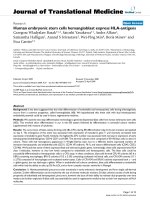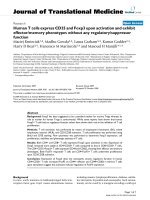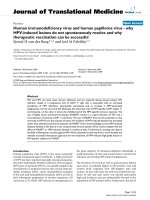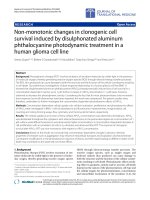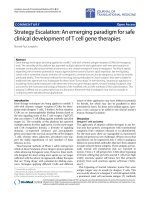báo cáo hóa học:" Human umbilical cord blood-derived mononuclear cell transplantation: case series of 30 subjects with Hereditary Ataxia" pdf
Bạn đang xem bản rút gọn của tài liệu. Xem và tải ngay bản đầy đủ của tài liệu tại đây (228.76 KB, 5 trang )
RESEARCH Open Access
Human umbilical cord blood-derived
mononuclear cell transplantation: case series of
30 subjects with Hereditary Ataxia
Wan-Zhang Yang
1
, Yun Zhang
2
, Fang Wu
1
, Min Zhang
1
, SC Cho
3
, Chun-Zhen Li
1
, Shao-Hui Li
1
, Guo-Jian Shu
1
,
You-Xiang Sheng
1
, Ning Zhao
1
, Ying Tang
1
, Shu Jiang
2
, Shan Jiang
2
, Matthew Gandjian
4
, Thomas E Ichim
4*
and
Xiang Hu
2*
Abstract
Background: The differential diagnosis for hereditary ataxia encompasses a variety of diseases characterized by
both autosomal dominant and recessive inheritance. There are no curative treatments available for these
neurodegenerative conditions. This open label treatment study used human umbilical cord blood-derived
mononuclear cells (CBMC) combined with rehabilitation training as potential disease modulators.
Methods: 30 patients suffering from hereditary ataxia were treated with CBMCs administered systemically by
intravenous infusion and intrathecally by either cervical or lumbar puncture. Primary endpoint measures were the
Berg Balance Scale (BBS), serum markers of immunoglobulin and T-cell subs ets, measured at baseline and pre-
determined times post-treatment.
Results: A reduction of pathological symptoms and signs was shown following treatment. The BBS scores, IgG, IgA,
total T cells and CD3+CD4 T cells all improved significantly compared to pre-treatment values (P < 0.01~0.001).
There were no adverse events.
Conclusion: The combination of CBMC infusion and rehabilitation training may be a safe and effective treatment
for ataxia, which dramatically improves patients’ functional symptoms. These data support expanded double blind,
placebo-controlled studies for these treatment modalities.
Background
Hereditary ataxias are a heterogeneous group of neuro-
degenerative disorders, characterized by degenerative
atrophy of the cerebellum, brain stem and/or spinal
cord. The primary sequelae are clinical manifestations of
dysarthria, dyscoordination of limbs, instability of gait,
and eventual loss of posture [1-3]. Spinocerebellar ataxia
(SCA) and Friedreich’s ataxia (FRDA) are the most com-
mon forms of hereditary ataxia. Genetic anticipation
usually occurs in familial patients, with symptoms and
signs getting more severe with each successive genera-
tion [2,3]. The disease is characterized by progressively
disabling clinical manifestations. Patients show
symptoms of gait instability or dysarthria and may begin
to fall without warning. Gradually they prese nt progres-
sive limitations in their activities, lose the ability to
walk, become bedridden and fully dependent, and most
commonly succumb to pulmonary infection as the cause
of death [2,4].
To date, no effective routine therapy is currently avail-
able for hereditary ataxia [5-7]. Stem cell therapies were
recently studied as an option to treat neurodegenerativ e
disorders as it may provide neuroprotection and possibly
promote regeneration [8-13]. In addition, studies on ani-
mal models [14,15] and humans [16,17] reported the
therapeutic safety and efficacy of ste m cell transpla nta-
tion in cerebellar ataxia. Human umbilical cord blood
(hUCB) proved to be a rich source of pluripotent stem
cells for clinical application in neurodegenerative dis-
eases [18,19]. The mononuclear cells derived from
* Correspondence: ;
2
Shenzhen Beike Cell Engineering Research Institution, Shenzhen, China
4
Medistem Inc, San Diego, CA, USA
Full list of author information is available at the end of the article
Yang et al. Journal of Translational Medicine 2011, 9:65
/>© 2011 Yang et al; l icensee BioMed Central Ltd. This is an Open Access article distributed under the terms of the Creative Commons
Attribu tion License ( which permits unrestricted use, distribution, and reproduction in
any medium, provided the original work is prope rly cited.
hUCB are mainly comprised of a heteroge nous popula-
tion of hematopoietic and mesenchymal stem cells,
endothelial progenitor cells and immature immunologi-
cal cells [16,20]. In this study, CBMC transplantation
wasexaminedasapotentialtherapyforhereditary
ataxia. Thirty sequential patients with heredit ary ataxias
were treated with non-matched, allogeneic CBMCs.
Treatment included both intravenous and intrathecal
infusion of CBMCs, combine d with propriocepti ve neu-
romuscular facilitation. Our results indicate this com-
bined treatment improved ataxia patients’ functionality
and quality of life.
Methods
Patient characteristics
Thirty patients with hereditary ataxia were recruited
between January 2006 - May 2007 from the Nanshan
Affiliated Hospital of Guangdong Medical College.
Twenty five subjects had confirmed SCA (Type 1: 1
case, Type 2: 8 cases, Type 3: 5 ca ses, Type 6: 4 cases,
unidentified genotype: 7 cases) and 5 cases of FRDA.
The mean age was 43.14 ± 12.77 (range 19 to 71 ye ars).
The male-female gender ratio was 18:12. On average,
patients had ataxias for 10.74 ± 5.89 years. The longest
disease duration at t he time of treatment was 26 years.
Patients treated came from Australia, Britain, Canada,
China, Chile, Italy, South Africa and U.S.A. There were
no significant demographic or baseline co-morbidity dif-
ferences in the 30 subject cohort.
The brain and cord MRI (Symphony 1.5T, Siemens,
Germany) confirmed atrophy in the cerebellar hemi-
spheres combined with atrophies at different levels in the
brainstem and the cervical and thoracic segments of the
spinal cord, but there were no signs of organic changes to
the brain parenchyma. As per protocol, the pre- and post-
treatment study tested for complete blood counts, routine
urine tests, liver function, re nal function, e lectrolytes,
sero-enzymology, blood glucose, blood lipids, cellular and
humoral immunity, routine cerebro-spinal fluid (CSF) and
biochemical markers (biochemistry analyzer, Beckman, US
and Epics-XL flow cytometer, Beckman, US).
Clinical treatment
All subjects were hospitalized while receiving CBMC
transplantations. The CBMCs were provided by Shenz-
hen Beike Biotechnology Co., Ltd. after hUCB collection
and mononuclear cell extraction, cultivat ion and harvest
[16]. Approximately 1-3 × 10
7
CBMCs were transfused
per injection. Patients received both intrathecal and
intravenous injections. The protocol, patient consent,
and safety measures were approved by the local institu-
tional review board of the Nanshan Affiliated Hospital
of Guangdong Medical College under the auspices of
the National Ministry of Health. Patients were explained
the experimental nature of the procedure and informed
consent was obtained from all patients before initiation
of treatment. CBMCs were administered by intravenous
infusion combined with intrathecal injection by either
cervical or lumbar puncture. Each patient received cell
transplantation four to six times - depending on the
patient’s condition, within an interval of five to seven
days. Two ml of CSF was removed and replaced by 2 ml
of cell suspension during the intrathecal injection. In
termsofintravenousinfusion,30mlofcellsuspension
was given through an intravenous catheter over 15-20
minutes. During stem cell treatment, rehabilitation
cycles of balance training (proprioceptive neuromuscular
facilitation) were given twice daily for four to six weeks,
each cycle lasting 30 minutes. The major techniques
employed in this training were: (1) visual compensation:
the aim was to improve the proprioceptor sensitivity
with the help of visual compensation; (2) using balance
boards: the states tested were from static to movin g; the
support tope was from stable to unstable; eyes were
from open to closed. A phased and sequenced manner
was chosen based on the result of balance evaluation.
The basis evaluation of treatment efficacy was executed
with the Berg Balance Scale (BBS), which consists of 14
items assessing the ability to stand up and to maintain
standing position despite internally produced perturba-
tions [21]. Each item is scored from 0 (unable) to 4
(safely done) with a maximum total score of 56 [21].
Criterion of therapeutic effect
There were no published criteria to measure therapeutic
efficacy in the treatment of ataxia. We applied an
accepted statistical methodology of 50% or greater
improvement from baseline in BBS score. In order to
quantitate the response further, >50% was deemed to be
markedly effective; 5%-49% was classified as effective,
while <5% improvement was deemed to be ineffective.
Statistics
Testing was standardized for each sample or examination.
Data were presented as means ± standard deviations
(
¯
x
±
s
). Change in each outcome variables between pre-
and post-treatment was assessed using paired T-test. Bon-
ferroni adjustment was made for multiple comparisons
within each kind of outcome variables. An outcome vari-
able was considered to be significant if p < 0.05/m, where
m = number of comparisons made for each kind of out-
comes. All statistical analyses were done using SPSS 13.0
statistical package. All statistical tests were two-sided and
a p-value < 0.05 was considered statistically significant.
Results
Administration of CBMCs via intrathecal and intrave-
nous routes was well tolerated during the clinical
Yang et al. Journal of Translational Medicine 2011, 9:65
/>Page 2 of 5
treatment course. With treatment, 13/30 BBS score
improved by >50% and 17/30 showed improvement
between 5% ~ 49%. The highest increase was 87.5%
while the lowest one was 18.8%. All showed marked
functional effects. The efficacy rate of balancing from
these samples was 100% (Table 1). The BBS score
improvement was significantly elevated after treatment
(Table 2, P < 0.001).
Of the immune parameters, there was significant
reduction in IgG 9.76 ± 3.079 vs 8.09 ± 2.357 and IgA
2.12 ± 0.808 vs 1.92 ± 0.760. The C3, C4 and IgM mea-
sures were n ot significantly altered (Table 3, P < 0.05/5
= 0.01). Total T cells 78.29 ± 8.011 vs 74.85 ± 8.588 and
CD3+CD4 T cells 49.07 ± 8.531 vs 44.93 ± 9.642 were
sig nificantly decreased after the treatment (Table 4, P <
0.05/4 = 0.0125).
Discussion
The frequency of exact diagnosis and con firmation of
hereditary ataxias has risen in tandem with advances in
genetic testing that define the different types and the
locus of genotype variation, abnor malities within chro-
mosomes and proteins. Mutational analysis can correlate
with apoptosis, necrosis or degeneration of neurons in
the cerebellum, brain stem, or spinal cord. The rate and
quantity of atrophy and degeneration of neurons differ
with the various types of hereditary ataxia and patients’
ages. The pathological neuronal loss results in loss of
cerebellospinal tracts and functional disorders. The phy-
sical manifestations translating to functional disability
include unsteadiness in walking, wide-based steps,
inability to heel walk, unsteadiness in standing or sitting,
dependence on a walking f rame, walking aid or wheel-
chair, dysarthria and dysphagia. Despite genotypic varia-
bility, the phenotypic symptoms among patients are
mostly similar, only differing in ages of onset or rates of
progression. According to the iconography records of
the FRDA subjects in this study, the onset of cerebellar
atrophy is approximately five years before symptoms
appear and the progression is in direct proportion to
the atrophy ratio of cerebellum and spinal cord. Patients
eventually develop severe functional impairment of swal-
lowing, loss of locomotor capacity a nd even death due
to respiratory muscle paralysis or pulmonary infection.
Prior studies attempt to treat neurodegenerative dis-
eases with human embryonic olfactory ensheathing cell
[22] and neural stem cell [17,23] transplantation. How-
ever, there are no publications documenting systematic
study of hereditary ataxia treatment with CBMCs. Based
on our clinical experie nce, the short-term effect o f
CBMC transplantation combined with rehabilitation
training on equilibrium function treating hereditary
ataxia was significant. After receiving one treatment
course, the patients were evaluated by physicians and
therapists using BBS, a validated functional scale that
measur es the ability to walk, balance while st anding and
other activities of daily living for ataxia patients [21].
The average duration of symptoms of the subjects
enrolled was over 10 years, and therefore, most received
equilibrium function training without significant
improvements prior to CBMC treatment. One of the
patients with SCA6 who needed complete support while
walking and had abnormal Romberg sign (+), heel-knee-
tibia test (+) and heel test (+) a t baseline, subjec tively
felt marked improvements immediately after the CBMC
transplantation and could objectively walk without sup-
port. He also finished the heel test after three CBMC
transplantations. In addition, this subject’ s condition
remained stable three years after the treatment accord-
ing to the follow up examinations.
One family from Sask atchewan, Canada had 32 indivi-
duals with confirmed SCA2 from 80 tested family mem-
bers spanning four generations. Sixteen members of the
family had already expired directly from the disease or
complications stemming from it. Six male siblings or
children from this family participated in the trial. The
symptoms in the third generation were relatively mild
and all were able to move with support. However, in the
fourth generation, symptoms started by age 16 years
old. Moreover, all signs and symptoms continued to
progress. By age 19, when one fourth generation family
member participated, he had al ready lost his ability to
walk. After one course of treatment, his BBS score rose
from 26/56 to 43/56. Unfortunately, because of geogra-
phical distance, it was impossible to provide long-term
Table 1 Efficacy Rate
BBS Score Improved
>50%
Improved
5~49%
Improved
<5%
Total
Patient #
(n)
13 17 0 30
Efficacy
Rate
43.3% 56.7% 0% 100%
Table 2 BBS score(
¯
x
±
s
)
Item Patient # (n) Pre-treatment Post-treatment P value
BBS Score 30 35.62 ± 11.25 45.25 ± 9.33 < 0.001
Table 3 Immunoglobulin (
¯
x
±
s
)
Item (Unit) Patient # (n) Pre-treatment Post-treatment P value
C3 (mg/l) 30 1.18 ± 0.247 1.19 ± 0.221 0.921
C4 (mg/l) 30 0.26 ± 0.073 0.25 ± 0.081 0.415
IgG (g/l) 30 9.76 ± 3.079 8.09 ± 2.357 <0.001
IgA (g/l) 30 2.12 ± 0.808 1.92 ± 0.760 0.001
IgM (g/l) 30 1.03 ± 0.792 1.05 ± 0.711 0.677
Yang et al. Journal of Translational Medicine 2011, 9:65
/>Page 3 of 5
follow-up details on all patients who received the
treatment.
The interval between baseline and post-treatment of
serum IgG, IgA, IgM, C3, C4 and T cell subsets tests, as
per protocol, was about a month. IgG, IgA, total T cells
and CD3+CD4 T cells decreased significantly after treat-
ment (P < 0.01). Although there are numerous p ropor-
tioned mechanisms of action, one possibility is that
CBMCs exercise broad inhibitory action on cellular and
humoral immunity. One limitation of the study was that
some patients received treatment with CBMC for 20
days in total, whereas others received up to 42 days in
total. There were no significant differences in immuno-
logical profiles or clinical responses between the 20 to
42 day treatment groups, however this is a question that
may be addressed in future studies.
Cord blood derived cells are being investigated in a
myriad of preclinical disease models [18,19,24,25]. The
safety of CBM C transplant ation has been investigated in
several human clinical trials with neurodegenerative
conditions and has not revealed any severe adverse
events, immune reactivity or Graft-versus-host-disease
[16,26,27]. The potential concern reg arding GVHD
induced by allogeneic cord blood administer ed in
absence of immune suppression is mitigated by the fact
that hundreds of administrations of allogeneic lympho-
cytes have been performed in women with recurrent
spontaneous abortions as a method of immune modula-
tion, without GVHD being observed [24]. Mechanism
studies suggest that multi-potent cells in the heteroge-
neous CBMC population may not only differentiat e into
osteoblasts, chondroblasts, adipocytes and neurons and
astrocytes to act as a cell replacement source, but also
produce antioxidants, several neurotrophic and angio-
genic factors and modulate immune and inflammatory
reaction [19,28,29]. Intravenously administe red CBMCs
enter brain, survive, migrate, improve functional recov-
ery and reduce infarct volume in the middle cerebral
artery occlusion rat stroke model through the action of
anti-inflammatory, neuropro tection and neovascular iza-
tion [30,31]. Cord blood stem cells infusion into the sys-
temic circulation of G93A mice, an amyotrophic lateral
sclerosis (ALS) model, delayed disease progression for 2-
3 weeks and increased lifespan of diseased mice by
providing cell replacement and protection of motor neu-
rons [32]. Transpl antation of hUCB cells into the spinal
cord injury (SCI) rats most likely inhibits the apoptotic
cascade which is followed by axonal remyelination,
regeneration of the damaged neural tissues, potential
restoration of blood flow to the damaged area by neo-
vascularization, and modulation of the immune/inflam-
matory response to the injury [33,34]. Accordingly,
these multiple restorative and protective effects from
CBMC grafts may act in harmony to exert therapeutic
benefits for hereditary ataxias, but the exact mechanism
of action still remains unconfirmed.
Conclusion
This open label single dose treatment case series using
CBMC transplantation in 30 subjects with hereditary
ataxia demonstrated statisticall y significant endpoints of
functional and surrogate immune marker changes from
baseline. In addition to the early effect seen in some
subjects, the measured symptomatic improvements per-
sisted throughout the period of the study, as noted with
the follow-up data from a subset of subj ects. These data
suggest a potential treatment using CBMC transplanta-
tion for he reditary ataxia and possibly other neurode-
generative conditions involv ing the spinal cord or
cerebellum. Based on the current data, further double-
blind placebo controlled studies are warranted to vali-
date the efficacy, safety and long-term effects.
Author details
1
Department of Rehabilitation Medicine, Nanshan Affiliated Hospital of
Guangdong Medical College, Shenzhen, China.
2
Shenzhen Beike Cell
Engineering Research Institution, Shenzhen, China.
3
Department of
Neurology and Neurosurgery, Stanford University, Stanford, CA, USA.
4
Medistem Inc, San Diego, CA, USA.
Authors’ contributions
WY conceived of the study, participated in its design and coordination,
carried out the clinical treatment and performed the statistical analysis. YZ
analyzed and interpreted data and drafted the manuscript. MZ, FW, CL, SL,
GS, YS, NZ, YT, Shan-J carried out the clinical treatment and collected data.
SC, Shu-J, MG, TI analyzed and interpreted data and helped to draft the
manuscript. XH conceived of the study, participated in its design and
coordination and helped to draft the manuscript. All authors read and
approved the final manuscript.
Competing interests
XH is a shareholder of Beike Biotechnology. No other authors declare any
competing interests.
Received: 30 January 2011 Accepted: 16 May 2011
Published: 16 May 2011
References
1. Wang WZ, Luo ZM: Neurology. Beijing: The People’s Medical Publishing
House , 5 2004, 286-290.
2. Furtado S, Das Sand Suchowersky O: A review of the inherited ataxias:
recent advances in genetic, clinical and neuropathologic aspects.
Parkinsonism and Related Disorders 1998, 4:161-169.
3. Schmitz-Hübsch T, Klockgether T: An update on inherited ataxias. Current
Neurology and Neuroscience Reports 2008, 8:310-319.
Table 4 T-cell subsets(
¯
x
±
s
)
Item Patient #
(n)
Pre-
treatment
Post-
treatment
P
value
Total T Cells
(%)
30 78.29 ± 8.011 74.85 ± 8.588 0.002
CD3+CD4 (%) 30 49.07 ± 8.531 44.93 ± 9.642 <0.001
CD3+CD8 (%) 30 23.81 ± 7.737 24.71 ± 7.737 0.954
Th/Tc (%) 30 2.29 ± 0.942 2.02 ± 0.815 0.147
Yang et al. Journal of Translational Medicine 2011, 9:65
/>Page 4 of 5
4. Fogel BL, Perlman S: Clinical features and molecular genetics of
autosomal recessive cerebellar ataxias. Lancet Neurol 2007, 6:245-257.
5. Brusse E, Maat-Kievit JA, Swieten JC: Diagnosis and management of early-
and late-onset cerebellar ataxia. Clin Genet 2007, 71:12-24.
6. Mancuso M, Orsucci D, Choub A, Siciliano G: Current and emerging
treatment options in the management of Friedreich ataxia.
Neuropsychiatric Disease and Treatment 2010, 6:491-499.
7. Santos R, Lefevre S, Sliwa D, Seguin A: Friedreich Ataxia: Molecular
Mechanisms, Redox Considerations, and Therapeutic Opportunities.
Antioxid Redox Signal 2010, 13:651-690.
8. Locatelli F, Bersano A, Ballabio E, Lanfranconi S, Papadimitriou D, Strazzer S,
Bresolin N, Comi GP, Corti S: Stem cell therapy in stroke. Cell Mol Life Sci
2009, 66:757-772.
9. Liang J, Zhang H, Hua B, Wang H, Wang J, Han Z, Sun LY: Allogeneic
mesenchymal stem cells transplantation in treatment of multiple
sclerosis. Multiple Sclerosis 2009, 15:644-646.
10. Martinez HR, Gonzalez-Garza MT, Moreno-Cuevas JE, Caro E, Gutierrez-
Jimenez E, Segura JJ: Stem-cell transplantation into the frontal motor
cortex in amyotrophic lateral sclerosis patients. Cytotherapy 2009,
11(1):26-34.
11. Roberts TJ, Price J, Williams SC, Modo M: Preservation of striatal tissue and
behavioral function after neural stem cell transplantation in a rat model
of Huntington’s disease. Neuroscience 2006, 139:1187-1199.
12. Redmond DE, Bjugstad KB, Teng YD, Ourednik V, Ourednik J, Wakeman DR,
Parsons XH, Gonzalez R, Blanchard BC, Kim SU, Gu Z, Lipton SA,
Markakis EA, Roth RH, Elsworth JD, Sladek JR, Sidman RL, Snyder EY:
Behavioral improvement in a primate Parkinson’s model is associated
with multiple homeostatic effects of human neural stem cells. Proc Natl
Acad Sci 2007, 104:12175-12180.
13. Corti S, Nizzardo M, Nardini M, Donadoni C, Salani S, Ronchi D, Saladino F,
Bordoni A, Fortunato F, Del BR, Papadimitriou D, Locatelli F, Menozzi G,
Strazzer S, Bresolin N, Comi GP: Neural stem cell transplantation can
ameliorate the phenotype of a mouse model of spinal muscular
atrophy. J Clin Invest 2008, 118:3316-3330.
14. Jones J, Jaramillo-Merchán J, Bueno C, Pastor D, Viso-León M, Martínez S:
Mesenchymal stem cells rescue Purkinje cells and improve motor
functions in a mouse model of cerebellar ataxia. Neurobiol Dis 2010,
40(2):415-423.
15. Chintawar S, Hourez R, Ravella A, Gall D, Orduz D, Rai M, Bishop DP,
Geuna S, Schiffmann SN, Pandolfo M: Grafting neural precursor cells
promotes functional recovery in a SCA1 mouse model. J Neurosci 2009,
29(42):13126-13135.
16. Yang WZ, Zhang Y, Wu F, Min WP, Minev B, Zhang M, Luo XL, Ramos F,
Ichim TE, Riordan NH, Hu X: Safety evaluation of allogeneic umbilical cord
blood mononuclear cell therapy for degenerative conditions. Journal of
Translational Medicine 2010, 8:75-80.
17. Zhang JW, Guo SG, Wang CJ, Sun T, Wang TH: Treatment of cerebellar
ataxia by neural stem cell transplantation. Journal of Medical Forum 2010,
31(18):19-20.
18. Garbuzova-Davis S, Sanberg CD, Kuzmin-Nichols N, Willing AE, Gemma C,
Bickford PC, Miller C, Rossi R, Sanberg PR: Human umbilical cord blood
treatment in a mouse model of ALS: optimization of cell dose. PLoS One
2008, 3(6):e2494.
19. Park DH, Borlongan CV, Willing AE, Eve DJ, Cruz LE, Sanberg CD, Chung YG,
Sanberg PR: Human umbilical cord blood cell grafts for brain ischemia.
Cell Transplant 2009, 18(9):985-998.
20. Javed MJ, Mead LE, Prater D, Bessler WK, Foster D, Case J, Goebel WS,
Yoder MC, Haneline LS, Ingram DA: Endothelial Colony Forming Cells and
Mesenchymal Stem Cells are Enriched at Different Gestational Ages in
Human Umbilical Cord Blood. Pediatr Res 2008, 64:68-73.
21. Yelnik A, Bonan I: Clinical tools for assessing balance disorders.
Neurophysiol Clin 2008, 38(6):439-445.
22. Chen L, Jiang Z, Huang HY, Zhang F, Liu YC, Xi HT, Wang HM, Ren YS,
Zhou CM: Preliminary Result of Olfactory Ensheathing Cell
Transplantation in Intractable Neuropathic Pain Following Spinal Cord
Injury: 17 Cases Report. Chinese Journal of Rehabilitation Theory and
Practice 2010, 16(2):146-148.
23. Zhang RY, Zheng YR, Hu SS, Cheng HB, An YH: Clinical analysis of neural
stem cells for treatment of sequela in 50 stroke patients. Chinese Journal
of Clinical Rehabilitation 2006, 20(9):138-139.
24. Riordan NH, Chan K, Marleau AM, Ichim TE: Cord blood in regenerative
medicine: do we need immune suppression? J Transl Med 2007, 5:8.
25. Yang WZ, Wu F, Zhang M, Yang JY, Liang HM, Sheng YX, Hu X, Zhao N,
Yang ZG, Tang Y: Cord Blood-derived Neural Stem Cell Transplantation in
Nervous System Diseases. Chinese Journal of Integrative Medicine on
Cardio-/Cerebrovascular Disease 2009, 7(3):287-290.
26. Yang WZ, Yang JY, Liang HM, Zhang M, Wu F, Sheng FX, Yang ZG, Tang Y,
Zhao N, Hu X, Jiang S, Guo SQ: Efficacy and Safety of Cord Blood Source
Neural Stem Cell for Amyotrophic Lateral Sclerosis. Chinese Journal of
Integrative Medicine on Cardio-/Cerebrovascular Disease 2007, 5(10):911-913.
27. Zhang M, Yang WZ, Sheng YX, Wu F, Liang HM, Zhao N, Hu X, Jiang S,
Guo SQ: Clinical Efficacy and Safety of Transplantation of Umbilical Cord
Blood Source Neural Stem Cells for Multiple Sclerosis. Practical Preventive
Medicine 2008, 15(4):1186-1188.
28. Newcomb JD, Sanberg PR, Klasko SK, Willing AE: Umbilical cord blood
research: current and future perspectives. Cell Transplant 2007,
16(2):151-158.
29. Arien-Zakay H, Lecht S, Bercu MM, Tabakman R, Kohen R, Galski H, Nagler A,
Lazarovici P: Neuroprotection by cord blood neural progenitors involves
antioxidants, neurotrophic and angiogenic factors. Exp Neurol 2009,
216(1)
:83-94.
30. Vendrame M, Cassady J, Newcomb J, Butler T, Pennypacker KR, Zigova T,
Sanberg CD, Sanberg PR, Willing AE: Infusion of Human Umbilical Cord
Blood Cells in a Rat Model of Stroke Dose-Dependently Rescues
Behavioral Deficits and Reduces Infarct Volume. Stroke 2004,
35:2390-2395.
31. Chen J, Sanberg PR, Li Y, Wang L, Lu M, Willing AE, Sanchez-Ramos J,
Chopp M: Intravenous Administration of Human Umbilical Cord Blood
Reduces Behavioral Deficits After Stroke in Rats. Stroke 2001,
32:2682-2688.
32. Garbuzova-Davis S, Willing AE, Zigova T, Saporta S, Justen EB, Lane JC,
Hudson JE, Chen N, Davis CD, Sanberg PR: Intravenous administration of
human umbilical cord blood cells in a mouse model of amyotrophic
lateral sclerosis: distribution, migration, and differentiation. J Hematother
Stem Cell Res 2003, 12(3):255-270.
33. Park DH, Lee JH, Borlongan CV, Sanberg PR, Chung YG, Cho TH:
Transplantation of Umbilical Cord Blood Stem Cells for Treating Spinal
Cord Injury. Stem Cell Rev 2011, 7(1):181-194.
34. Dasari VR, Spomar DG, Gondi CS, Sloffer CA, Saving KL, Gujrati M, Rao JS,
Dinh DH: Axonal Remyelination by Cord Blood Stem Cells after Spinal
Cord Injury. J Neurotrauma 2007, 24(2):391-410.
doi:10.1186/1479-5876-9-65
Cite this article as: Yang et al.: Human umbilical cord blood-derived
mononuclear cell transplantation: case series of 30 subjects with
Hereditary Ataxia. Journal of Translational Medicine 2011 9:65.
Submit your next manuscript to BioMed Central
and take full advantage of:
• Convenient online submission
• Thorough peer review
• No space constraints or color figure charges
• Immediate publication on acceptance
• Inclusion in PubMed, CAS, Scopus and Google Scholar
• Research which is freely available for redistribution
Submit your manuscript at
www.biomedcentral.com/submit
Yang et al. Journal of Translational Medicine 2011, 9:65
/>Page 5 of 5


